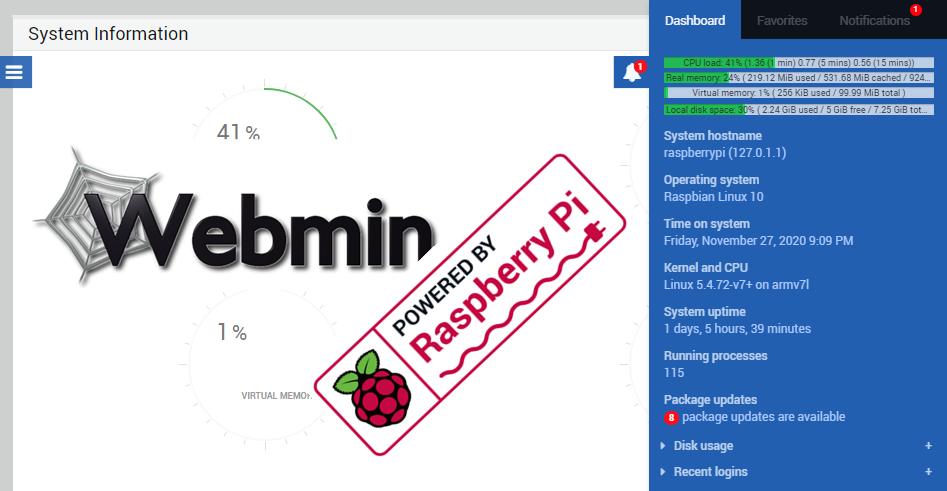

If installing NGINX on the Raspberry Pi went as planned, you’ll see a friendly “Welcome to nginx” message when you navigate to in a browser. To view your IP address, you may run the command hostname -I. As such, you can test if NGINX installed properly by navigating to RASPBERRY PI'S IP ADDRESS]/. NGINX places an HTML file under the web folder. So let’s type the following command into terminal to start up the web server on your Raspberry Pi. Now with NGINX installed, we can now start up the software.
#Raspberry pi webmin install
Select the hard disk that you want to monitor and then click on the ‘Save’ button.įirst, let’s install NGINX onto our Raspberry Pi by running the following command on your Raspberry Pi. This will require package ‘smartmontools’ to be installed. To set this up, go to Webmin > Tools > System and Server Status and add a monitor of type ‘SMART Drive Check’. You may also want Webmin to notify you when there’s a hard disk failure. Click the ‘Save’ button and go back and try to send a test email.
#Raspberry pi webmin password
Enter your email address and password for SMTP server authentication and choose ‘Login’ for SMTP authentication method. Also, change SMTP SSL encryption to ‘Always use TLS’. You may want to configure sending email by going to Webmin > Webmin Configuration > Sending Email and select to send email via SMTP to remote mail server and enter your email server address. Now exit the SSH console and try your new username with your favorite FTP Client. Go back to the SSH console and run the following: $ sudo chown username /var/www/yourdomain (folder you previously created or whatever folder you want the ftp user to own) It will complete the process and take you back to the users list page. Select “New group with same name as user” for the primary group.Ĭlick on “Create”. Select the /var/Select “Normal Password” and provide a unique, complex password for the account. As “Home directory” select “Directory” and press the button to show the folders in your server. Provide a username for what is to be the FTP account. Go to Webmin > System > Users and Groups, and select “Create a new user. Save the file but leave the SSH connection open as there is one more thing we need to do.

Look for the line that contains DefaultRoot and uncomment it by removing the “#” from it. You can also install ProFTP server by entering the following: $ sudo apt-get install proftpd See Network Booting Raspbian Lite to a Raspberry Pi 4 from a Synology NAS or Network Booting LibreElec to Raspberry Pi’s from a Synology NAS for more help on setting up a TFTP server.

Once this is done, go ahead and restart the tftpd-hpa service. You will need to create a folder called tftpboot on the external HDD and change the owner and group for it to tftp. Then apply the changes with the following: $ exportfs -ra TFTP_DIRECTORY="/media/external/tftpboot"Īlso, add the following lines to your /etc/exports file: # to NFS clients. Then install the ‘nfs-kernel-server’ and ‘tftpd-hpa’ packages and modify /etc/default/tftpd-hpa to the following: TFTP_USERNAME="tftp" media/external/tftpboot /export/tftpboot none bind If you will be running a TFTP server, then also add the following to fstab: # Create NFS export folder. Then add the following lines to the fstab file to bind the home folder to the one on the external drive: /media/external/home /home none bind Reboot and then create a folder called ‘home’ on the external drive. dev/sda1 /media/external ext4 defaults 0 0 Then modify the fstab file to automatically mount the external HDD by adding the following lines: # Mount external drive containing home directories on boot. Once installed, log into Webmin and go to System > Disk and Network Filesystems and create a EXT4 filesystem on your external drive if you haven’t already done so. You will now be able to install with the commands: sudo apt-get install apt-transport-httpsĪll dependencies should be resolved automatically.

You should also fetch and install the Webmin GPG key with which the repository is signed, with the commands: wget
#Raspberry pi webmin update
If you like to install and update Webmin via APT, edit the /etc/apt/sources.list file on your system and add the line: deb sarge contrib


 0 kommentar(er)
0 kommentar(er)
